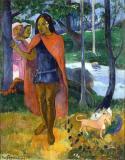Art Of The Day Weekly
#365 - from 20 November 2014 to 26 November 2014

Paul Gauguin, Le sorcier d'Hiva Oa or Le Marquisien à la cape rouge, 1902 © © Musée des Beaux-Arts de Liège (Bal) © Ville de Liège.
When Hitler sold degenerate art
LIÈGE – Art historian Jean-Patrick Duchesne carried out an investigation for over a decade to reconstruct a unique auction that took place at the Grand Hôtel de Lucerne, in Switzerland, on 30 June 1939. There was nothing innocent about it. The Nazi leaders, after emptying their museums from all “degenerate” art and lighting a huge fire in the Fire station of Berlin, in March 1939, wanted to explore a new path. Couldn’t this despised art bring in some money and finance the war effort? The 125 works selected, all from museums and not from spoliations, presented a wide array of refused works, something of an art history. Gauguin, Van Gogh, Chagall, Ensor, Marie Laurencin, Picasso, Kokoschka. Jews, mentally disabled, homosexuals, decadent, reckless and feminist artists. A local learned man, Jules Bosmant, the future director of the museum of Beaux-Arts, got wind of the auction, and moved heaven and earth to gather 5 million Belgian Francs. This allowed the city to buy nine masterpieces, though the most sought after, a Van Gogh, was bought under their nose by the Fogg Art Museum from Harvard. The nine masterpieces are presented in a sort of chiaro-oscuro lighting, (among them The Soler Family by Picasso) and are accompanied by 17 other paintings and sculptures that were sold at the same auction and then scattered in other collections through the world.
• L’art dégénéré selon Hitler, la vente de Lucerne, 1939 at the Cité Miroir, from 17 October 2014 to 29 March 2015.
• The catalogue (Collections historiques de l’Université de Liège, 232 p.) lists the 125 works of the auction and their respective destinies.
